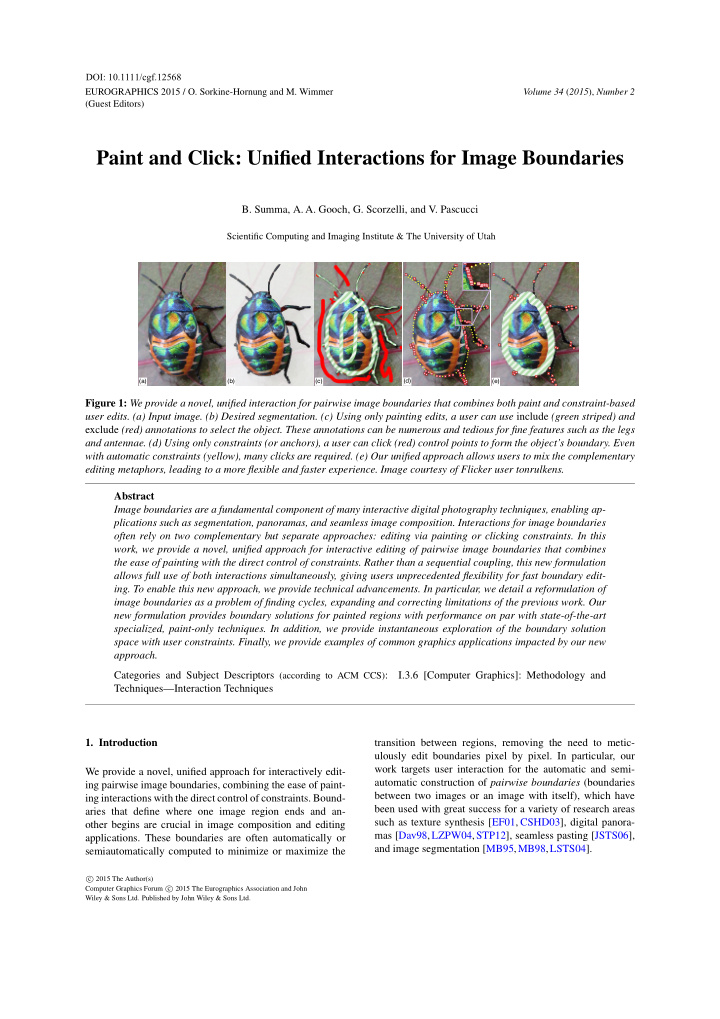



DOI: 10.1111/cgf.12568 EUROGRAPHICS 2015 / O. Sorkine-Hornung and M. Wimmer Volume 34 ( 2015 ), Number 2 (Guest Editors) Paint and Click: Unified Interactions for Image Boundaries B. Summa, A. A. Gooch, G. Scorzelli, and V. Pascucci Scientific Computing and Imaging Institute & The University of Utah (a) (b) (c) (d) (e) Figure 1: We provide a novel, unified interaction for pairwise image boundaries that combines both paint and constraint-based user edits. (a) Input image. (b) Desired segmentation. (c) Using only painting edits, a user can use include (green striped) and exclude (red) annotations to select the object. These annotations can be numerous and tedious for fine features such as the legs and antennae. (d) Using only constraints (or anchors), a user can click (red) control points to form the object’s boundary. Even with automatic constraints (yellow), many clicks are required. (e) Our unified approach allows users to mix the complementary editing metaphors, leading to a more flexible and faster experience. Image courtesy of Flicker user tonrulkens. Abstract Image boundaries are a fundamental component of many interactive digital photography techniques, enabling ap- plications such as segmentation, panoramas, and seamless image composition. Interactions for image boundaries often rely on two complementary but separate approaches: editing via painting or clicking constraints. In this work, we provide a novel, unified approach for interactive editing of pairwise image boundaries that combines the ease of painting with the direct control of constraints. Rather than a sequential coupling, this new formulation allows full use of both interactions simultaneously, giving users unprecedented flexibility for fast boundary edit- ing. To enable this new approach, we provide technical advancements. In particular, we detail a reformulation of image boundaries as a problem of finding cycles, expanding and correcting limitations of the previous work. Our new formulation provides boundary solutions for painted regions with performance on par with state-of-the-art specialized, paint-only techniques. In addition, we provide instantaneous exploration of the boundary solution space with user constraints. Finally, we provide examples of common graphics applications impacted by our new approach. Categories and Subject Descriptors (according to ACM CCS) : I.3.6 [Computer Graphics]: Methodology and Techniques—Interaction Techniques transition between regions, removing the need to metic- 1. Introduction ulously edit boundaries pixel by pixel. In particular, our work targets user interaction for the automatic and semi- We provide a novel, unified approach for interactively edit- automatic construction of pairwise boundaries (boundaries ing pairwise image boundaries, combining the ease of paint- between two images or an image with itself), which have ing interactions with the direct control of constraints. Bound- been used with great success for a variety of research areas aries that define where one image region ends and an- such as texture synthesis [EF01, CSHD03], digital panora- other begins are crucial in image composition and editing mas [Dav98,LZPW04,STP12], seamless pasting [JSTS06], applications. These boundaries are often automatically or and image segmentation [MB95,MB98,LSTS04]. semiautomatically computed to minimize or maximize the � 2015 The Author(s) c Computer Graphics Forum c � 2015 The Eurographics Association and John Wiley & Sons Ltd. Published by John Wiley & Sons Ltd.
Recommend
More recommend